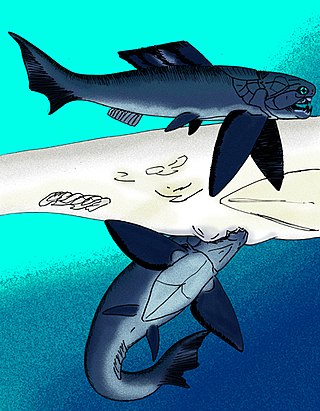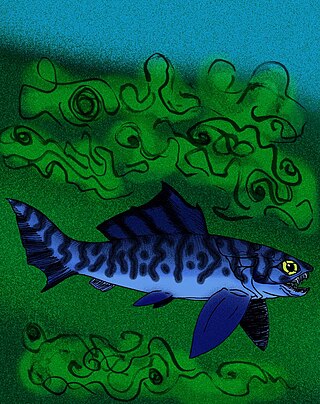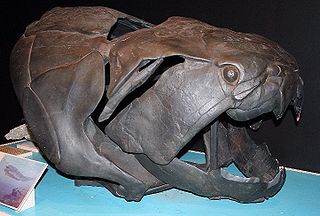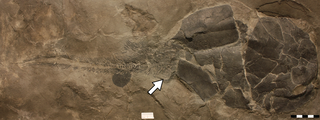Related Research Articles

Arthrodira is an order of extinct armored, jawed fishes of the class Placodermi that flourished in the Devonian period before their sudden extinction, surviving for about 50 million years and penetrating most marine ecological niches. Arthrodires were the largest and most diverse of all groups of placoderms.

Coccosteus is an extinct genus of arthrodire placoderm from the Devonian period. Its fossils have been found throughout Europe and North America. The majority of these have been found in freshwater sediments, though such a large range suggests that they may have been able to enter saltwater. It was a small placoderm, with Coccosteus cuspidatus measuring 29.6–39.4 cm (11.7–15.5 in) long.

Dinichthys is an extinct monospecific genus of large marine arthrodire placoderm from the Late Devonian measuring around 3 metres (9.8 ft) long. Fossils were recovered from the Ohio Shale Formation along the Olentangy River in Delaware County, Ohio.

Brachythoraci is an extinct suborder of arthrodire placoderms, armored fish most diverse during the Devonian.

Dicksonosteus is an extinct genus of basal arthrodire placoderm fish which lived during the Early Devonian period of Spitsbergen, Norway.

Plourdosteus is an extinct genus of placoderm arthrodire which was relatively widespread in Euramerica during the Givetian to Frasnian ages of the Devonian. It was a small placoderm, with P. canadensis specimen MNHM 2-177 measuring 37.5 cm (14.8 in) long.

Mcnamaraspis is an extinct monospecific genus of arthrodire placoderm that inhabited the ancient reef system of north Western Australia during the Frasnian epoch of the Late Devonian period. The type specimen was found and described by John A. Long from the Gogo Formation near Fitzroy Crossing. This fossil fish showed new anatomical features in arthrodires, like the well-preserved annular (ring-shaped) cartilages of the snout, previously inferred to be present by Erik Stensiö of Sweden. It is occasionally referred to as "The Gogo Fish" after the locale the holotype was excavated from.
Camuropiscidae is a family of mostly small, bullet or spindle-shaped extinct arthrodire placoderms from the Late Devonian. With the exception of the snub-nosed Simosteus, camuropiscid placoderms are characterized by an elongated, tubular snout. The entire family is restricted to the Frasnian Gogo Reef Formation of Australia.

Fallacosteus is an extinct monospecific genus of arthrodire placoderm from the Early Frasnian stage of the Late Devonian period, found at the Gogo Formation of Kimberley, Western Australia. As with almost all other camuropiscids, F. turneri had an elongated snout that may have enhanced its hydrodynamic streamlining.

Camuropiscis is an extinct genus of arthrodire placoderm from the Early Frasnian stage of the Late Devonian period, found at the Gogo Formation of Kimberley, Western Australia. The species of Camuropiscis had a flattened, elongated snout that may have aided in enhancing its hydrodynamic streamlining.

Latocamurus is an extinct monospecific genus of flat-nosed arthrodire placoderm from the Early Frasnian stage of the Late Devonian period, found at the Gogo Formation of Kimberley, Western Australia.

Hadrosteus is an extinct monospecific genus of large arthrodire placoderm from the Late Frasnian Kellwasserkalk facies of Bad Wildungen, Germany. It had large, double-pronged inferognathals, and serrated edges along its mandible, strongly suggesting that it was a fish-eating predator. The head had a triangular snout, and the trunkshield was short, but high, with a median dorsal plate that was broader than wide. The average skull length is about 16 centimeters.

Xiangshuiosteus wui is an extinct monospecific genus of brachythoracid arthrodire placoderm from the Late Emsian stage of the Early Devonian epoch, discovered in Wuding County of Yunnan province, China. It has recently been reassessed as a dunkleosteid.

Eubrachythoraci is an extinct clade of arthrodire placoderms within the suborder Brachythoraci, armored fish most diverse during the Devonian. Most are considered to be pelagic long-distance swimmers, leading to their widespread distribution beginning from at least the Middle Devonian period.

Pachyosteomorphi is an extinct clade of arthrodire placoderms within the Eubrachythoraci, armored fish most diverse during the Devonian. Most are considered to be pelagic long-distance swimmers, leading to their widespread distribution beginning from at least the Middle Devonian period.

Panxiosteidae is an extinct family of arthrodire placoderms that lived during the Devonian period.

Coccosteomorphi is an extinct clade of arthrodire placoderms within the Eubrachythoraci, armored fish most diverse during the Devonian. Most are considered to be pelagic long-distance swimmers, leading to their widespread distribution beginning from at least the Middle Devonian period.

Millerosteus is an extinct genus of coccosteid arthrodire placoderm from the Early Givetian stage of the Middle Devonian period. Fossils are found in Orkney and Caithness, Scotland. It was a small placoderm with a body length of 14 cm (5.5 in). Millerosteus is one of the few arthrodires known from specimens preserving the entire skeleton.
Dickosteus is an extinct genus of coccosteid arthrodire placoderm from the Late Eifelian to Early Givetian stages of the Middle Devonian period. Fossils are found in Orkney and Caithness, Scotland. It was a small placoderm with a total body length of 43.7 cm (17.2 in). It is one of the few placoderms for which complete bodies are known.

Watsonosteus is an extinct genus of coccosteid arthrodire placoderm from the Late Givetian stage of the Middle Devonian period. Fossils are found in the Orkney Islands, Scotland. It was a small placoderm with a total body length of 57 cm (22 in), with the largest individuals reaching lengths of 1 m (39 in). It is one of the few arthrodires for which complete body fossils are known.
References
- 1 2 ZHU Min; WANG Jun-qing; WANG Shi-tao. (2010). "A new antarctaspid arthrodire (placoderm fish) from the Lower Devonian of Guangxi, China" (PDF). Vertebrata PalAsiatica. 48 (2): 101–110.
- ↑ Zhu, Min (January 2010). "A New Antarctaspid Arthrodire (Placoderm Fish) from the Lower Devonian of Guangxi, China". 古脊椎動物學報.







